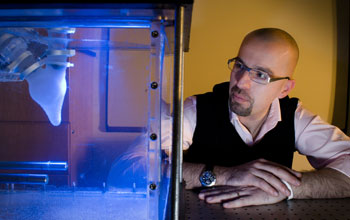Multimedia Gallery
Engineers Stem Progression of Heart Disease (Image 1)
Paul Vlachos, an associate professor of mechanical engineering and director of the Advanced Experimental Thermofluid Engineering Research Lab at Virginia Tech, is working on a series of cardiac-related projects. Vlachos and his students hope to develop novel tools for diagnosing, monitoring and treating heart disease, as well as improve existing ones. (Date of Image: Spring 2009) [Image 1 of 4 related images. See Image 2.]
More about this Image
Currently, not enough is known about cardiovascular flows--how blood courses through arteries and veins. Through his research, Paul Vlachos hopes to gain a better understanding of the flow of blood in and out of the heart and improve drug delivery and artery stents. He's also working on creating a system that can mimic the sounds of a diseased heart in order to develop sensors that, from vibrations, can form a diagnosis.
Some of the projects currently being worked on in Vlachos' lab are:
- Cardiac diastolic dysfunction diagnosis. Kelley Stewart, a doctoral student in mechanical engineering, and John Charonko, a doctoral student in biomedical engineering, are collaborating with cardiologists at Wake Forest University School of Medicine to improve Doppler echocardiograph and MRI diagnostics of cardiac diastolic dysfunction. Diastolic dysfunction--usually caused by hypertension or high blood pressure--is when the heart chambers do not fill smoothly with blood. Diagnosing such a problem is difficult because the heart compensates for the deficiency. Stewart and Charonko developed a new methodology based on the physics of fluid flow that allows existing medical technology to present a more comprehensive picture of the heart's function.
Vlachos, Stewart and collaborators studied how the heart's left ventricle fills, and used this information to develop an automated algorithm to analyze the stage of diastolic dysfunction and determine whether the heart is healthy or not. Preliminary results show an increase in diagnostic consistency and repeatability over conventional methods. The researchers are hopeful that the algorithm will reduce errors in diagnostics and deliver a better, more reliable detection tool for the medical community. - Improving stent implantation. Implanting stents--small metal tubes made out of wire mesh that are inserted into an artery to open blockages and allow the blood to flow freely--can be very hard on the body. Charonko and Satya Karri, also a doctoral student in biomedical engineering in Vlachos' lab, are working to design stents that are more compatible with the body and reduce the need for repeat procedures. The students have been studying how different stent designs affect the flow of blood and how small changes in their design or use may lead to changes in the forces experienced by the arterial walls.
- Better-targeting drug delivery. Prescribed medicine may affect other areas of the body in addition to their target, which can result in toxic side effects. Jaime Schmieg, a doctoral student in biomedical engineering in Vlachos' lab, is experimenting with ways to cut the collateral damage. Her goal: Selectively attack diseased tissue but leave the surrounding healthy tissue unaffected. Vlachos says if a drug can be made or directed to an exact spot where, for example, a stent is located for a patient who has an artery stenosis, then unintended side effects would not hinder the process. A patient taking medication for the flu or for pain could have no side effects such as drowsiness or lethargy.
[This information was taken from Virginia Tech's Research Magazine, Summer 2009 issue. The complete story, "Engineers seek to stem massive, deadly flow of heart disease," is available Here.]
Credit: Photo by John McCormick; courtesy Virginia Tech
See other images like this on your iPhone or iPad download NSF Science Zone on the Apple App Store.
Images and other media in the National Science Foundation Multimedia Gallery are available for use in print and electronic material by NSF employees, members of the media, university staff, teachers and the general public. All media in the gallery are intended for personal, educational and nonprofit/non-commercial use only.
Images credited to the National Science Foundation, a federal agency, are in the public domain. The images were created by employees of the United States Government as part of their official duties or prepared by contractors as "works for hire" for NSF. You may freely use NSF-credited images and, at your discretion, credit NSF with a "Courtesy: National Science Foundation" notation.
Additional information about general usage can be found in Conditions.
Also Available:
Download the high-resolution JPG version of the image. (3.6 MB)
Use your mouse to right-click (Mac users may need to Ctrl-click) the link above and choose the option that will save the file or target to your computer.



